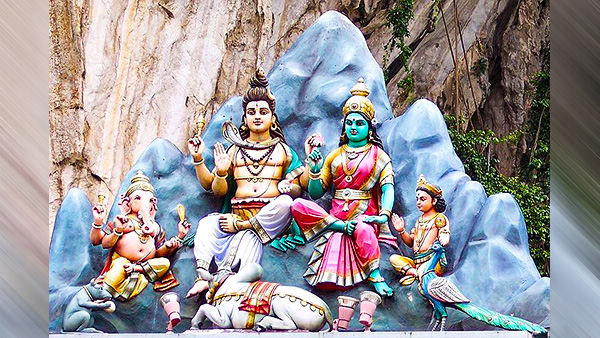Just In
- 1 min ago

- 6 hrs ago

- 7 hrs ago

- 11 hrs ago

Don't Miss
- Movies
 Crew Box Office Collection Day 21: Kareena's Film Barely Sees Growth; Crosses Rs 70 Cr In 3 Weeks
Crew Box Office Collection Day 21: Kareena's Film Barely Sees Growth; Crosses Rs 70 Cr In 3 Weeks - Finance
 8 Tata Group Stocks To Buy That Will Pay Dividends Soon, Q4 In Focus; Are You Invested?
8 Tata Group Stocks To Buy That Will Pay Dividends Soon, Q4 In Focus; Are You Invested? - Sports
 Australia Women Cricketer Ashleigh Gardner gets engaged to partner Monica Wright
Australia Women Cricketer Ashleigh Gardner gets engaged to partner Monica Wright - News
 Iran Embassy In Paris Cordoned Off Following Reports Of Suspect With Explosives
Iran Embassy In Paris Cordoned Off Following Reports Of Suspect With Explosives - Automobiles
 Suzuki Swift Hatchback Scores 4 Star Safety Rating At JNCAP – ADAS, New Engine & More
Suzuki Swift Hatchback Scores 4 Star Safety Rating At JNCAP – ADAS, New Engine & More - Education
 NLSIU Announces the Rajiv K. Luthra Foundation Grant
NLSIU Announces the Rajiv K. Luthra Foundation Grant - Technology
 Dell Introduces AI-Powered Laptops and Mobile Workstations for Enterprises in India
Dell Introduces AI-Powered Laptops and Mobile Workstations for Enterprises in India - Travel
 Journey From Delhi To Ooty: Top Transport Options And Attractions
Journey From Delhi To Ooty: Top Transport Options And Attractions
Bheema Amavasya Vrat 2022: Date, Time, Puja Ritual, Vrat Katha, History And Significance
Bheema Amavasya, predominantly a colourful women's festival, is a celebration of conjugal love whose chief purpose is to pray for the extension of the husband's longevity and for the general wellbeing of all the male members in the family.

This is also an opportune time for unmarried girls to pray to the Lord to grant them a good prospective groom. Lord Shiva and Goddess Parvati are worshipped on this day for the seekers to be blessed with prosperity, progeny, marriage, longevity, success and wellbeing. During Ashadha, ladies, also make it a point to stay in their parental homes to later join their husbands on the new moon day or Bhimana Amavasya and continue with their marital journey.
Known by other names such as Gandana puja, Pati Sanjeevini Vrat, Jyotistambha Vrat, Bheemana Amavasya is the last day in the Ashadha month, that is going to arrive, this time, on 28 July 2022. In South Kannada, it is called Aati Amavasya whereas in the North Kannada it is known by the name" Kode Amavasya." Celebrated largely in South Indian states like Karnataka, Andhra Pradesh and some regions in Tamil Nadu, on a new moon day of Ashadha, it is a precursor to many upcoming auspicious events, and festivals. Go through the article for detailed information on Bheema Amavasya.
Bheema Amavasya Vrat 2022: Date And Time
Bheema Amavasya Vrat is celebrated on 28 July 2022. Auspicious time for the puja should begin at 8:00 am and conclude at 12:43 am. Varjyam time is between 03:59 pm to 05:46 pm.
Bheema Amavasya Vrat 2022: Puja Rituals
One must get up in the early hours of Brahmi muhurta, cleanse themselves with a ritual bath, wear fresh setoff clothes, and draw the rangolis inside and outside of the house. Then the housewives should tie a yellow thread with a yellow flower on their hands, and meditate on Bheemeshwar and commence the vrat which should actually be conducted during auspicious muhurats.
Pour a handful of rice on a plate and place two lit oil lamps on the rice heap. Invoke the divine couple with prayers on to this plate and worship them. Tie 9 knots of Gauri dara along with puja materials and tie it on your wrist after the puja concludes. Invoke Ganesha before beginning the worship and then follow it up with Bhimeshwar puja. Offer 9 blackberries and sweets as bhog to God and distribute it amongst others in the family. Lastly, take the blessings of the husband as, on this day, he should be seen as an element of Lord Mahadeva. As per the Puranas, it is mandatory to carry out the udyapan after the vrat observance, for about 5,9, or 16 years after the marriage, along with a fast that has to be observed alongside.
Bheema Amavasya Vrat 2022: Vrat Katha
A long time ago, in the state of Saurashtra (Gujarat), there lived a brave virtuous king called Vajra bahu who had a valorous handsome son by name Jayasheela. He succumbed to death, unfortunately when he had just entered the prime of his youth. Violently shocked about his death and worried that there would no peace or liberation for his soul, since he was childless, he announced to his subjects that he would gift his entire kingdom to that person who is prepared to marry his daughter to the King's dead son. He was hoping that this measure would help him in achieving his purpose.
A well-read pious Brahmin scholar, who had been living in utter poverty and squalour in his kingdom, was impressed with this idea and gave his daughter Susheela in marriage to the king's dead son. Soon after the marriage ceremony was over, it was time for the death ceremony of the groom, and as he was carried to his funeral pyre, the king ordered his daughter in law to light the pyre of his son, after the initial formalities were done. The unsuspecting daughter-in-law, who accepted the offer meekly, lit the pyre the next moment after which, it started raining heavily and the pyre was washed off by the rains. King along with his attendants left the pyre and the girl with her dead husband and returned to his palace.
The girl, who was mortified by the idea of staying with a dead body in the cremation ground, the entire night, naturally prayed to Lord Shiva and Goddess Parvati to bless her with a miracle and release her husband from the realms of the other world. Lord Shiva responded to her fervent prayers, with a darshan, and advised her to perform the Jyotirbheemeshvara vrat or Deepastambha vrat after which she would definitely get back her husband. The innocent girl, with firm faith in Lord Shivas words, did as she was told.
In the subsequent moment, there was a miracle and the dead prince rose to life and the cemetery turned into a palatial mansion. At last, the prayers of the young girl were answered, by none other than Lord Shiva. As this news reached the palace, King Vajrabahu, pleased with the results of his daughter-in-law's penance arrived at the scene, pacified his inconsolable daughter-in-law, and everybody, elated in the new found happiness, left for the Palace.

Bheema Amavasya Vrat 2022: History And Significance
This was the day, Lord Shiva accepted Goddess Parvati as his consort, as a response to the gruelling 108 janmas of penance observed by Goddess Parvati. This was also the day of the divine communion of God Shiva and Goddess Parvati.
All Amavasya are treated as sacred by the Hindus. As per the scriptures, any offering made devoutly to the departed ancestors, brings blessings in huge measure to the offsprings on earth. Goddess Parvati blesses her devotees with fertility, marital happiness, spiritual powers and prowess, and undying love towards one's husband who would be blessed with long and happy life. Unmarried girls, with the performance of this vrat, are guaranteed a happy marriage with a virtuous groom.
Disclaimer: The information is based on assumptions and information available on the internet and the accuracy or reliability is not guaranteed. Boldsky does not confirm any inputs or information related to the article and our only purpose is to deliver information. Kindly consult the concerned expert before practising or implementing any information and assumption.
Image sources: Wikimedia Commons
-
 yoga spiritualityThrissur Pooram 2024: Date, Time, History, Significance, And Celebrations Related To Kerala's Rich Traditions
yoga spiritualityThrissur Pooram 2024: Date, Time, History, Significance, And Celebrations Related To Kerala's Rich Traditions -
 yoga spiritualityKamada Ekadashi 2024 Wishes: Greetings, Messages, Texts, Images, Twitter Status And Instagram Captions
yoga spiritualityKamada Ekadashi 2024 Wishes: Greetings, Messages, Texts, Images, Twitter Status And Instagram Captions -
 yoga spiritualityChaitra Navratri 2024 Day 9: Maa Siddhidatri Puja Vidhi, Vrat Katha, Mantra, And Aarti Lyrics
yoga spiritualityChaitra Navratri 2024 Day 9: Maa Siddhidatri Puja Vidhi, Vrat Katha, Mantra, And Aarti Lyrics -
 yoga spiritualityKamada Ekadashi 2024 Mantras To Chant On This Auspicious Day To Fulfill Desires
yoga spiritualityKamada Ekadashi 2024 Mantras To Chant On This Auspicious Day To Fulfill Desires -
 yoga spiritualityChaitra Navratri 2024 Day 8: Maa Mahagauri Puja Vidhi, Vrat Katha, Mantra, And Aarti Lyrics
yoga spiritualityChaitra Navratri 2024 Day 8: Maa Mahagauri Puja Vidhi, Vrat Katha, Mantra, And Aarti Lyrics -
 yoga spiritualityChaitra Durga Ashtami 2024 Wishes, Greetings, Messages, Images, Posters, Twitter, And Instagram Status
yoga spiritualityChaitra Durga Ashtami 2024 Wishes, Greetings, Messages, Images, Posters, Twitter, And Instagram Status -
 astrologyRam Navami 2024: Lucky Zodiac Signs Who Will Get Special Blessings Of Lord Rama And Will Be More Fortunate
astrologyRam Navami 2024: Lucky Zodiac Signs Who Will Get Special Blessings Of Lord Rama And Will Be More Fortunate -
 yoga spiritualityWhen Is Kamada Ekadashi 2024? Confirmed Date, Puja Rituals, Why Fasting Is Significant On This Day
yoga spiritualityWhen Is Kamada Ekadashi 2024? Confirmed Date, Puja Rituals, Why Fasting Is Significant On This Day -
 yoga spiritualityChaitra Navratri 2024 Day 7: Maa Kalratri Puja Vidhi, Vrat Katha, Mantra and Aarti Lyrics
yoga spiritualityChaitra Navratri 2024 Day 7: Maa Kalratri Puja Vidhi, Vrat Katha, Mantra and Aarti Lyrics -
 yoga spiritualityChaitra Navratri 2024 Day 6: Maa Katyayani Puja Vidhi, Vrat Katha, Mantra and Aarti Lyrics
yoga spiritualityChaitra Navratri 2024 Day 6: Maa Katyayani Puja Vidhi, Vrat Katha, Mantra and Aarti Lyrics -
 yoga spiritualityChaiti Chhath Puja 2024 Wishes, Greetings, Texts, Messages, Images, WhatsApp, Twitter And Instagram Status
yoga spiritualityChaiti Chhath Puja 2024 Wishes, Greetings, Texts, Messages, Images, WhatsApp, Twitter And Instagram Status -
 yoga spiritualityChaitra Navratri 2024 Day 5: Maa Skandmata Puja Vidhi, Katha, Mantra And Aarti
yoga spiritualityChaitra Navratri 2024 Day 5: Maa Skandmata Puja Vidhi, Katha, Mantra And Aarti


 Click it and Unblock the Notifications
Click it and Unblock the Notifications



